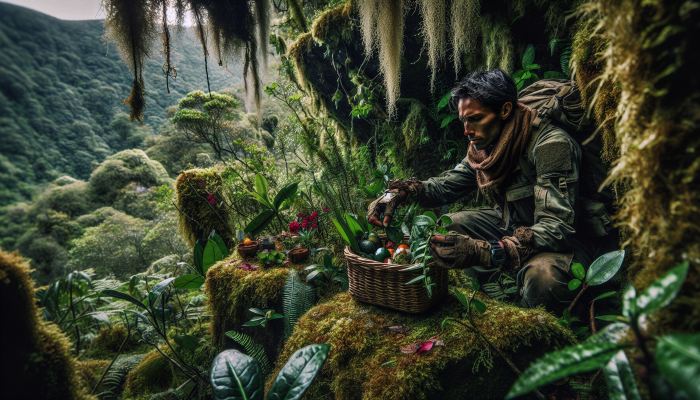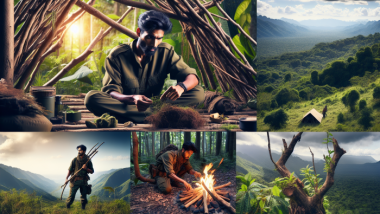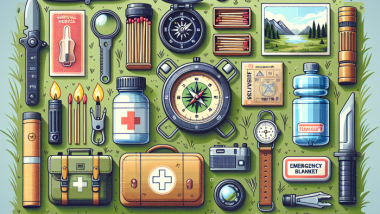Surviving in the wilderness involves mastering a range of skills, and one of the most crucial is foraging for food. In the vast expanse of the wild, knowing how to identify edible plants, mushrooms, and other resources can mean the difference between sustenance and starvation. This practical guide delves into the art of foraging, providing survivalists with essential tips and techniques to source nourishment from nature. From recognizing safe food sources to preparing wild edibles, this article will equip you with the knowledge needed to thrive in the untamed landscape.

Introduction to Foraging in the Wilderness
Foraging in the wilderness is a fundamental skill for any survivalist venturing into the great outdoors. This art involves sourcing food directly from nature, relying on the land’s resources to sustain oneself. Understanding the basics of foraging is essential, as it not only provides nourishment but also connects individuals to the environment in a profound way. As a survival strategy, foraging teaches self-reliance and fosters a deep appreciation for the abundance of nature.
In the wild, knowing how to identify edible plants, fruits, nuts, and mushrooms is key to successful foraging. It requires a keen eye, knowledge of seasonal availability, and understanding of the local ecosystem. Starting with the introduction to foraging lays the foundation for mastering this vital survival skill, enabling individuals to thrive in the wilderness with confidence.
Benefits of Learning to Forage for food
Learning to forage for food in the wilderness not only equips survivalists with essential sustenance skills but also offers a multitude of benefits. Firstly, foraging enhances self-reliance and self-sufficiency, empowering individuals to depend less on modern conveniences. It fosters a deep connection to nature, as foragers learn to observe, respect, and interact with the environment around them. Additionally, foraged foods are often more nutritious and free from harmful chemicals present in processed foods, promoting better health and well-being. By mastering the art of foraging, individuals gain a valuable survival skill that can be crucial in emergency situations and wilderness expeditions. Furthermore, foraging instills a sense of accomplishment and pride in being able to provide for oneself using resources directly from the land, fostering independence and resourcefulness.
Rules and Ethics of Foraging
When foraging for food in the wilderness, it’s crucial to adhere to rules and ethics to ensure sustainability and respect for the environment. One fundamental rule is to never harvest more than what is needed for immediate consumption, allowing plant populations to regenerate and maintain ecosystem balance. Respect for private property and protected areas is essential, as foraging without permission can lead to legal consequences and harm fragile habitats. Ethical foraging involves properly identifying plant species to prevent accidental harvest of endangered or poisonous plants. Additionally, leaving no trace behind by minimizing impact on the surroundings is a key principle. By following these rules and ethics of foraging, survivalists can enjoy the bounty of nature while preserving its beauty and diversity for future generations.

Identifying Edible Plants in the Wild
Identifying edible plants in the wild is a crucial skill for wilderness survival enthusiasts. To avoid potential dangers, it’s essential to be able to distinguish between safe, nutritious plants and toxic ones. Begin by learning to recognize common edible species, such as dandelions, wild strawberries, and cattails, which are abundant in various landscapes. Utilize guidebooks or attend wilderness survival training courses to deepen your knowledge on plant identification. Pay close attention to key features like leaf shape, color, smell, and growth pattern to accurately identify plants. Remember, the “universal edibility test” is not recommended for amateurs; rely on expert guidance instead. By honing your ability to identify edible plants, you enhance your foraging skills and increase your chances of finding nourishment in the wild.
Common Edible Plants and Their Nutritional Value
Exploring the wilderness for food sources unveils a treasure trove of common edible plants rich in essential nutrients vital for survival. Wild plants like dandelions offer a significant source of vitamins A, C, and K, while stinging nettles provide iron, calcium, and protein. Foraging for chickweed can supply your body with vitamins B and C, along with minerals such as potassium and magnesium. The humble cattail is a versatile survival food, offering a high-calorie, carbohydrate-rich base for sustenance. These plants not only sustain you in the wild but also contribute to a well-rounded diet, ensuring your nutritional needs are met in challenging environments. Understanding the nutritional value of common edible plants is key to thriving in the wilderness and enhancing your wilderness survival skills.
Recognizing Poisonous Plants to Avoid
When foraging in the wilderness, being able to differentiate between edible plants and poisonous ones is crucial for survival. Recognizing poisonous plants to avoid is a skill that every survivalist should master to prevent potentially deadly mistakes. Common poisonous plants such as poison ivy, poison oak, and deadly nightshade have distinct characteristics that set them apart from their harmless counterparts. Learning to identify warning signs like specific leaf patterns, colors, or unusual fruits can help you steer clear of these dangers. It’s essential to research and familiarize yourself with toxic plant species in your region to stay safe while foraging. Remember, when in doubt, it’s best to err on the side of caution and avoid consuming any plant that you are unsure about.
Foraging for Protein Sources: Insects and Small Creatures
When foraging for protein sources in the wilderness, turning to insects and small creatures can be a valuable survival skill. Insects like crickets, grasshoppers, and mealworms are rich in protein and can provide a much-needed energy boost. Small creatures such as frogs, snails, or even small fish present additional options for protein intake. Knowing how to properly identify, catch, and prepare these resources can significantly enhance your chances of survival in a wilderness scenario. A wilderness survival training that includes instruction on insect and small creature foraging can be incredibly beneficial. Having the right tools in your wilderness survival kit, such as a small net or fishing line, can make capturing these protein sources easier. By learning to embrace these unconventional food sources, you expand your wilderness survival skills and increase your resilience in challenging environments.

Harvesting and Cooking Wild Edibles
Harvesting and cooking wild edibles is a fundamental skill for wilderness survivalists, enabling them to utilize the bounty of nature to sustain themselves. When foraging for wild plants, it is essential to gather specimens only if you are certain of their edibility. Once you have safely harvested your wild edibles, cooking them properly is crucial to enhance their flavors and nutritional value. Simple cooking methods such as boiling, sautéing, or roasting can transform foraged ingredients into delicious and nourishing meals. Utilizing basic utensils from your wilderness survival kit, such as a portable stove or a campfire, can make cooking in the wild a rewarding experience. By mastering the art of harvesting and cooking wild edibles, survivalists can enjoy a diverse and sustainable diet while honing their wilderness survival skills.
Tools and Equipment for Foraging
Having the right tools and equipment is essential for successful foraging in the wilderness. A well-equipped forager will carry items such as a reliable wilderness survival knife, a sturdy backpack to store finds, a compass for navigation, and a field guide on edible plants. A wilderness survival kit with essentials like a first aid supplies, waterproof matches, and a signaling device can be a lifesaver in emergency situations. Additionally, a foraging basket or container is handy for collecting berries, nuts, and other wild edibles without damaging them. A trusty water bottle and a lightweight portable stove for cooking are also valuable assets when venturing into the wild to forage. By investing in the appropriate tools and equipment, survivalists can enhance their foraging experience and improve their chances of thriving in the wilderness.
Creating a Foraging Plan and Strategy
Creating a foraging plan and strategy is essential for successful wilderness survival. Begin by researching the local flora and fauna to identify potential food sources. Utilize wilderness survival books and guides to learn about edible plants in your area. Develop a systematic approach by mapping out foraging locations and noting the best times of day for different types of foraging. Include considerations for seasonality and environmental factors in your plan. Pack your wilderness survival kit with essential tools such as a reliable knife and containers for harvesting and storing wild edibles. Incorporate training from wilderness survival courses to enhance your foraging skills. By strategizing your foraging activities, you can ensure a more efficient and safer experience in the wild, increasing your chances of finding sustenance to support your survival needs.
Foraging Tips for Different Seasons and Environments
Foraging for food in the wilderness requires adaptability based on the changing seasons and diverse environments. In spring, focus on tender young shoots, green leafy vegetables, and early flowers like dandelions. Summer offers a bounty of berries, fruits, and a variety of edible flowers. Fall is ideal for nuts, acorns, and edible mushrooms like chanterelles. Winter foraging may involve digging for roots, searching for mosses, lichens, and pine needles rich in Vitamin C. Remember to research and understand the specific flora and fauna of each season and region. Always be cautious of poisonous lookalikes, especially when plants change appearance throughout the year. Stay equipped with proper gear, like a trustworthy knife and a reliable wilderness survival kit, tailored to the challenges presented by different seasons and environments.
Preserving and Storing Foraged Foods
Preserving and storing foraged foods is essential for long-term wilderness survival. After successfully gathering edible plants, fruits, and nuts from the wild, it’s crucial to extend their shelf life through proper preservation methods. One effective technique is dehydrating foraged foods, which reduces moisture content and inhibits bacterial growth. For longer-lasting storage, vacuum-sealing or using airtight containers can help maintain freshness and prevent spoilage. Additionally, learning how to properly store dried foods in a cool, dry place away from direct sunlight can further prolong their edibility. By mastering the art of preserving and storing foraged foods, survivalists can ensure a sustainable source of nourishment in the wild, adding a layer of preparedness to their wilderness survival arsenal.
Safety Considerations During Foraging Activities
When engaging in foraging activities in the wilderness, prioritizing safety is paramount to a successful and secure experience. Before setting out to collect wild edibles, ensure you have appropriate wilderness survival training to recognize potential hazards and mitigate risks. Pack essential items from your wilderness survival kit, including a first aid kit, navigation tools, and communication devices, to handle emergencies effectively. Refer to reputable wilderness survival books or guides that detail safety protocols specific to foraging. Always carry a sharp wilderness survival knife to safely harvest plants and prepare food in the field. Be cautious of poisonous plants and mushrooms by learning to identify them accurately. Alert someone about your foraging plans and establish a predetermined meeting point to ensure communication in case of separation. By adhering to safety considerations, you can enjoy the art of foraging while staying vigilant and protected.
Conclusion and Final Thoughts on Mastering the Art of Foraging
Mastering the art of foraging is a vital skill for survivalists venturing into the wilderness. By honing their ability to identify edible plants, animals, and insects, individuals equip themselves with the knowledge needed to sustain themselves in the wild. While wilderness survival training and the use of a well-equipped wilderness survival kit are essential, the ability to forage for food adds an extra layer of self-sufficiency. As you delve into the world of foraging, remember the importance of continuous learning and practice. Explore wilderness survival books that detail the various plant species and foraging techniques. A reliable wilderness survival knife is also a crucial tool for harvesting and preparing wild edibles. In conclusion, mastering the art of foraging enhances your wilderness survival skills, making you more resilient and adaptable in the face of nature’s challenges.


